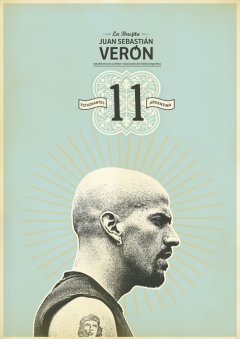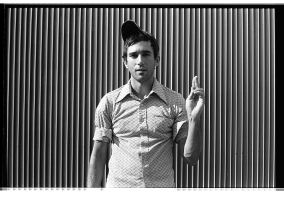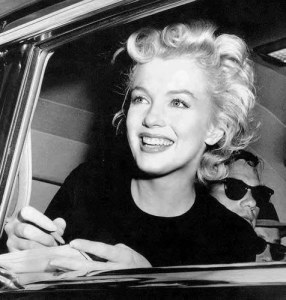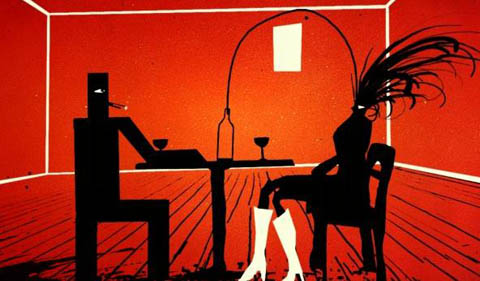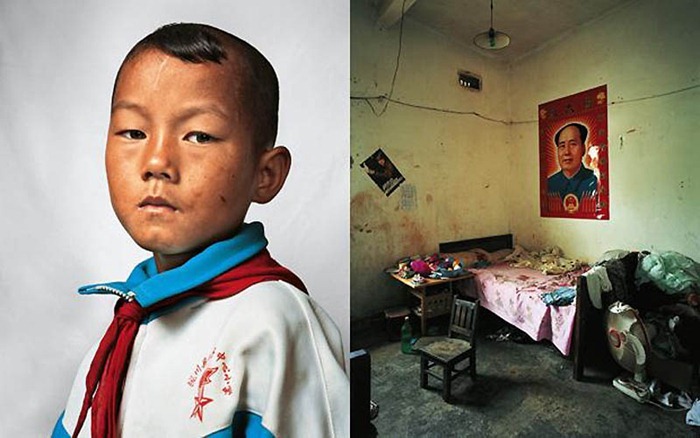“It started with the most horrible assignment I ever had,” Banning told me when when he dropped by our office yesterday. The job was in Mozambique: Banning’s editor had asked him to shoot pictures for a story on the decentralization of the administration of Dutch development aid. “That’s not something that makes your heart beat faster as a photographer,” he noted. To make it interesting for himself, he decided to shoot portraits of the bureaucrats themselves. Little did he know that this would be merely the first leg on an absurd odyssey that would take him through thousands of government offices, a world tour of what he calls “the shop windows of the state.”
Content dictated form. “What is bureaucracy?” Banning asked. “First of all, it’s square, so I used a square format. Second, it’s straight lines, and in the middle of that grid you’ve got this round being, this human being. And the camera is a metaphor for the local citizen who enters that space. So I always put myself directly in front of the desk or at ninety degrees to the desk, to get that Mondrian structure.”
The element of surprise was crucial. Given any warning, the bureaucrats would try to tidy their workspaces, but Banning wanted to see each office in all its cluttered glory, just as an everyday citizen would encounter it.
What Bureaucracy around the world looks like
India, Bihar

Sushma Prasad (b. 1962) is an assistant clerk at the Cabinet Secretary of the State of Bihar (population 83 million) in The Old Secretariat in the state capital, Patna. She was hired “on compassionate grounds” because of the death of her husband, who until 1997 worked in the same department. Monthly salary: 5,000 rupees ($ 110, euro 100).

Surinder Kumar Mandal (b. 1946) is circle inspector of taxes in Thakurganj block, collecting taxes in a specific part of Kishanganj district, State of Bihar. Monthly salary: 9,500 rupees ($ 208, 189 euro). Surinder Kumar Mandal (b. 1946) is “circle inspector” van belastingen in Thakurganj Block, Kishanganj district, State of Bihar. Maandsalaris: 9,500 rupees (euro 189, US$ 208).

Typeroom in the Finance Department of “the Old Secretariat” in the state capital Patna. The seemingly rusty old typewriters are awaiting use: the department is supposed to be 40% understaffed. The presence of several snoring employees gives a different suggestion.
China, Shandong

Qu Shao Feng (b. 1964) is chief general of Jining Public Security Bureau Division of Aliens and Exit-Entry Administration in Jining City, Shandong province. Monthly salary: 3,100 renminbi (US$ 384, 286 euro).

Wang Ning (b. 1983) works in the Economic Affairs office in Gu Lou community, Yanzhou city, Shandong province. She provides economic assistance to enterprises in her region and is the liaison officer between the government and local enterprises. Wang Ning is not married. She lives at home with her parents. Monthly salary: 2,100 renminbi (US$ 260, euro 228).
France, Auvergne

Roger Vacher (b. 1957) is a narcotics agent with the national police force in Clermont-Ferrand, Puy-de-Dome department, Auvergne region. Monthly salary: euro 2,200 (US$ 2,893).

Maurice Winterstein (b. 1949) works in Clermont-Ferrand for the Commission for the Advancement of Equal Opportunity and Citizenship at the combined administrative offices of the Auvergne region and the Puy-de-Dome department. He also is in charge of the portfolio of religious affairs, Islam in particular. Monthly salary: euro 1,550 (US$ 2,038). The young lady next to him is Linda Khettabi (b. 1989), an intern pursuing training as a secretary.
Liberia

Major Adolph Dalaney works in the Reconstruction Room of the Traffic Police at the Liberia National Police Headquarters in the capital Monrovia. Traffic accident victims at time are willing to pay a little extra if Dalaney’s department quickly draws up a favorable report to present to a judge. Monthly salary: barely 1,000 Liberian dollars ($18, €17).

Henry Gray (1940), acting commissioner for Gbaepo district, Kanweaken, River Gee County. During the Civil War, the office was completely looted and destroyed: only one wall remained. Gray has 11 personnel, of whom only 4 are paid. The rest are volunteers. He has no budget and over two years salary owing. Yesterday, he went to the capital Fishtown to collect last two months salary, two times 975 Liberian dollars (2x US$ 17, 2x euro 16). All he got was 600 dollars (US$ 11, euro 10). Gray is father to 34 children (sic), 13 of them depending, and has 18 grandchildren.
Russia, Siberia

Marina Nikolayevna Berezina (b. 1962), a former singer and choir director, is now the secretary to the head of the financial department of Tomsk province”s Facility Services. She does not want to reveal her monthly salary.

Nikolajevich Ilyich Volkov (b. 1954) is administrator of the village of Alexandrovskoye (some 1,000 inhabitants), Tomsk province. Monthly salary: 9,000 rubles (US$ 321, euro 243).
USA, Texas

Rudy Flores (b. 1963) is one of the 118 Texas Rangers, state law enforcement officers who cover 254 counties between them. He is based in Palestine, Anderson County, Texas, and is responsible for three counties. Monthly salary: $5,000 (€3,720).
 Dede McEachern (b. 1969) is director of licensing, Texas Department of Licensing and Regulations, in the state capital, Austin. Monthly salary: US$ 5,833 (euro 4,240).
Dede McEachern (b. 1969) is director of licensing, Texas Department of Licensing and Regulations, in the state capital, Austin. Monthly salary: US$ 5,833 (euro 4,240).
Yemen
 Ali Abdulmalik Shuga (b. 1964) is responsible for the archives of the Ministry of Trade and CommerceÍs governorate s office in the city of Taizz, Taizz Governorate. Monthly salary: 30,500 rial (US$ 171, euro 117).
Ali Abdulmalik Shuga (b. 1964) is responsible for the archives of the Ministry of Trade and CommerceÍs governorate s office in the city of Taizz, Taizz Governorate. Monthly salary: 30,500 rial (US$ 171, euro 117).
 Nadja Ali Gayt is an adviser at the Ministry of Agriculture’s education center for rural women in the district of Manakhah, Sana’a Governorate. Monthly salary: 28,500 rial ($160, €110).
Nadja Ali Gayt is an adviser at the Ministry of Agriculture’s education center for rural women in the district of Manakhah, Sana’a Governorate. Monthly salary: 28,500 rial ($160, €110).
Bolivia, Potosi

Constantino Ayaviri Castro (b. 1950), previously a construction worker, is a police officer, third class, for the municipality of Tinguipaya, Tomas Frias province. The police station does not have a phone, car or typewriter. Monthly salary: 800 bolivianos ($100, €189).
 Marcial Castro Revollo (b. 1942) is shopkeeper and, at the desk in the back, civil servant for the Registry of Births, Deaths and Marriages in the village of Millares (350 inhabitants), municipality of Betanzos, Cornelio Saavedra province, Department Potosi. Also, at the desk in the front, he is responsible for the polling station of the Corte Departemental Electoral de Potosi (elections office). Monthly salary: 500 bolivianos (euro 55, US$ 62).
Marcial Castro Revollo (b. 1942) is shopkeeper and, at the desk in the back, civil servant for the Registry of Births, Deaths and Marriages in the village of Millares (350 inhabitants), municipality of Betanzos, Cornelio Saavedra province, Department Potosi. Also, at the desk in the front, he is responsible for the polling station of the Corte Departemental Electoral de Potosi (elections office). Monthly salary: 500 bolivianos (euro 55, US$ 62).

Bolivia (2005) — David Ruiz Doro (b. 1972) is chief of urban and environmental projects at the Department of Public Works’ Technical Division of the municipality Potosí, the capital of the department by the same name. Monthly salary: 2,400 bolivianos (euro 267, US $299).
More Photos here:
This slideshow requires JavaScript.
More about Jan Banning:

- Location: Utrecht, The Netherlands
- www.janbanning.com
- Twitter: @jan_banning
- Jan Banning was born in the Netherlands in 1954 from Dutch-East-Indies parents. He studied social and economic history at the University of Nijmegen, and has been working as a photographer since 1981. The central theme of Banning’s practice is state power, having produced series about the longterm consequences of war and the world of government bureaucracy.
Source: The New Yorker’s Photo Department and janbanning.com
Tags: Bureaucracy, government, Netherlands, Photo, Photography

















































 Typeroom in the Finance Department of “the Old Secretariat” in the state capital Patna. The seemingly rusty old typewriters are awaiting use: the department is supposed to be 40% understaffed. The presence of several snoring employees gives a different suggestion.
Typeroom in the Finance Department of “the Old Secretariat” in the state capital Patna. The seemingly rusty old typewriters are awaiting use: the department is supposed to be 40% understaffed. The presence of several snoring employees gives a different suggestion.













 Bolivia (2005) — David Ruiz Doro (b. 1972) is chief of urban and environmental projects at the Department of Public Works’ Technical Division of the municipality Potosí, the capital of the department by the same name. Monthly salary: 2,400 bolivianos (euro 267, US $299).
Bolivia (2005) — David Ruiz Doro (b. 1972) is chief of urban and environmental projects at the Department of Public Works’ Technical Division of the municipality Potosí, the capital of the department by the same name. Monthly salary: 2,400 bolivianos (euro 267, US $299).










